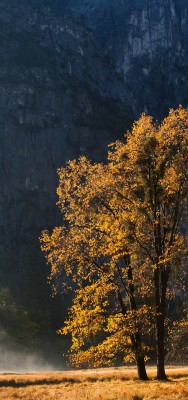The Tuesday Composition: Areas of High Contrast

If you like this article, you can now get the book! Joe has expanded the “Tuesday Composition” series into an inspiring new ebook on composition, especially for nature photography. Check it out: The Tuesday Composition.
In a previous column we’ve talked about how the eye is attracted to and tends to follow along edges in a scene, and that similarly, the eye tends not to spend much time wandering in the center of silhouetted areas, tending to explore the edges of those areas instead. Both of these ideas are related to the fact that as one looks at an image over time, the eye will spend more time looking at areas of high contrast than areas of lower contrast. If your image is half-solid without texture, and half a simple textured pattern, the viewers’ eyes will tend (depending, of course, on the dozens of other factors that go into human perception) to spend more time wandering around the patterns.
This autumn image from Yosemite Valley demonstrates the principle. As we look at the image over time, our eye spends a lot of time wandering around the tree branches and leaves compared to the shadowed valley walls or the thin strip of foreground grasses. If we were just trying to understand why our eye spends more time on the tree than the valley wall we might think it was just a matter of the tree leaves being highlights that our eyes are attracted to. But here, while our eyes might very well be first attracted to the brightest part of the image (the grasses at the base of the image), the the eye will eventually spend more time wandering the more interesting and complex patterns of the branches. And the large contrast in the tree leaves (both color contrast and tonal contrast) is a primary reason why. (more…)